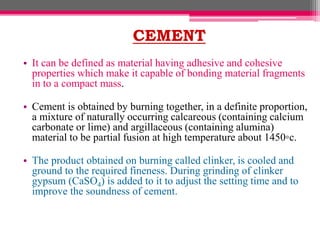The document provides a comprehensive overview of cement, detailing its definition, composition, types, and historical development. It explains the manufacturing processes of cement, focusing on the differentiation between natural and artificial (including Portland) cements, and addresses the chemical reactions involved during hydration that lead to setting and hardening. Additionally, it includes insights into the function of gypsum in cement and the hydration processes that develop strength over time.









![Raw materials of Portland Cement and it’s use
Calcareous materials, CaO [eg.
Limestone ]
• Principal Constituent and its proportion can
be regulated
• Excess of lime reduces the strength and
makes the cement expand & disintegrate
• Lesser amount of lime also reduces the
strength by quick setting
Argillaceous materials, Al2O3 and SiO2
[eg. Clay ]
• Imparts strength
• Makes quick setting
• Excess of alumina weakens the cement
Powdered Coal or fuel oil
• For burning
Gypsum (CaSO4 2H2O)
• Retards and enhances quick setting
.](https://image.slidesharecdn.com/cement-190903132236/85/Cement-10-320.jpg)















![Setting and Hardening : Day Wise
Day 1 :
• When cement is mixed with water, hydration of tricalcium aluminate (C3A)
takes place within a day
• The paste becomes rigid, which is known as Initial set or Flash set
• To avoid early setting of C3A , gypsum is added which acts as retarding
agent
3CaO . Al2O3 + 6H2O 3CaO . Al2O3 . 6H2O + 880 kJ/Kg
C3A + 6H2O C3A . 6H2O + 880 kJ/Kg
[OR]
Tricalciumaluminate Hyderated tricalcium aluminate (Crystalline)
C3A + 3CaSO4 . 2H2O C3A . 3CaSO4 . 2H2O
Caclium sulpho aluminate](https://image.slidesharecdn.com/cement-190903132236/85/Cement-26-320.jpg)
![Setting and Hardening : contd…
Day – 2 to 7 :
• After hydration of C3A, C3S beings to hydrate to give tobermonite gel and
crystalline Ca(OH)2, which is responsible for initial strength of the cement
• The hydration of C3S gets completed within 7 days
2[3CaO .SiO2] + 6H2O 3CaO.2SiO2 . 3H2O + 3Ca(OH)2 + 500 kJ/Kg
Tricalcium silicate Tobermonite gel Crystalline
2C3S + 6H2O C3S2 . 3H2O + 3Ca(OH)2 + 500 kJ/Kg
[OR]
Tobermonite gel possesses a very high surface area and very high adhesive property](https://image.slidesharecdn.com/cement-190903132236/85/Cement-27-320.jpg)
![Setting and Hardening : Chemical Reactions contd…
Day – 7 to 28 :
• Dicalcium silicate (C2S) reacts with water very slowly and gets completed in 7
to 28 days
• Increase of strength is due to formation of tobermonite gel and crystalling
Ca(OH)2 of both C2S and C3S
2[2CaO . SiO2 ] + 4H2O 3CaO .2SiO2 . 3H2O + Ca(OH)2 + 250 kJ/Kg
2C2S + 4H2O C3S2 . 3H2O + Ca(OH)2 + 250 kJ/Kg
Dicalcium silicate Tobermonite gel Crystalline
[OR]](https://image.slidesharecdn.com/cement-190903132236/85/Cement-28-320.jpg)
![Setting and Hardening : Chemical Reactions contd…
• After initial hyderation of tetracalcium alumino ferrite (C4AF) , hardening takes place
through crystallization , along with C2S
4CaO . Al2O3 . Fe2O3 + 7H2O 3CaO . Al2O3 . 6H2O + CaO . Fe2O3 . H2O + 420 kJ/Kg
Tetracalcium alumino ferrite Crystalline Gel
C4AF + 7H2O C3A . 6H2O
[OR]
Graphical representation of development of compressive strength
“Hydration and Hydrolysis of Bogue
compounds causes cement to develop
compressive strength”(Shown in the
figure )](https://image.slidesharecdn.com/cement-190903132236/85/Cement-29-320.jpg)
















